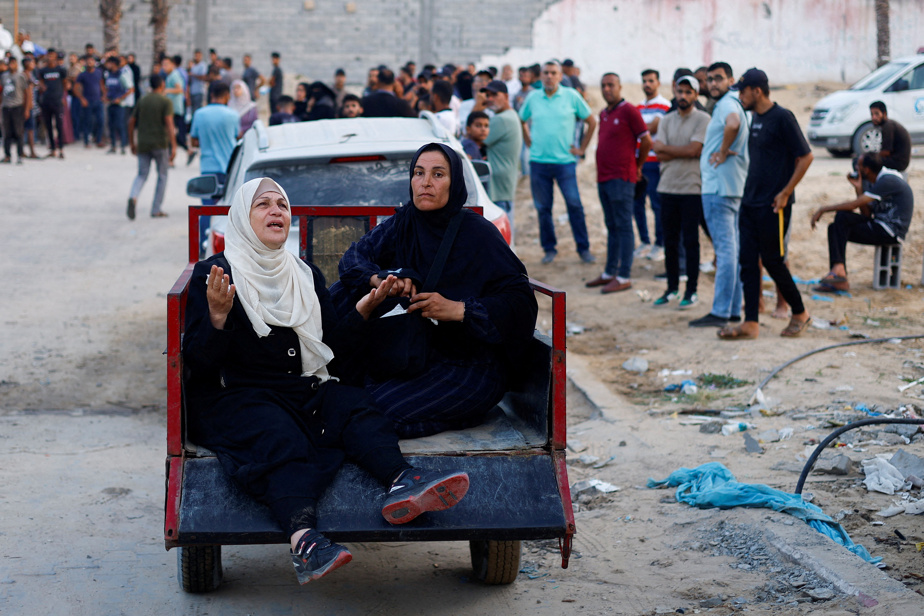Twenty-two people were killed and 45 others injured in gunfire that damaged the office of the International Committee of the Red Cross (ICRC) in Gaza, which is surrounded by hundreds of displaced people, the organization said on Friday evening.
This new violence comes as the Israeli army intensifies its strikes on the Gaza Strip in which at least 30 Palestinians were killed during the day on Friday according to doctors, and as it exchanged new cross-border fire with Lebanese Hezbollah .
Lebanon cannot become “another Gaza”, warned UN boss Antonio Guterres, highlighting fears of a regional conflagration with the increase in shootings on the Israeli-Lebanese border and the threats brandished by Israel and Hezbollah, a movement armed and financed by Iran.
“Massive influx of victims”
According to the ICRC, Friday evening’s shooting “caused a massive influx of victims to the nearby Red Cross field hospital” which “received 22 dead and 45 wounded”, the organization writes on .
The Ministry of Health of the government of the Gaza Strip, territory ruled by the Palestinian Islamist movement Hamas, for its part reported 25 dead and 50 injured, accusing the Israelis of having “targeted the tents of displaced civilians in Al -Mawasi”, area in the south of the Gaza Strip, near Rafah.
For his part, an Israeli army spokesperson told AFP that “an initial investigation suggests that there is nothing to indicate that a strike was carried out by the IDF (Israeli army, Editor’s note) in the humanitarian zone of Al-Mawasi”. “The incident is being investigated,” the spokesperson added.
According to the ICRC, “shooting so dangerously close to humanitarian structures, the location of which is known to the parties to the conflict and which are clearly marked with the Red Cross emblem, endangers the lives of civilians and Cross staff -Red “.
The war in Gaza, triggered by a bloody attack by the Palestinian Islamist movement Hamas on October 7 against Israeli soil, has also caused new tensions between Israel and the United States, historic allies, with Prime Minister Benjamin Netanyahu criticizing the pace deliveries of American military aid.
Intensification of strikes
On Friday, Israeli aerial and artillery bombardments intensified according to witnesses in several sectors of the Palestinian territory besieged by Israel since October 9.
“It was a difficult and very violent day in Gaza City (north). So far, around 30 martyrs have been transported to Al-Ahli Hospital,” said Dr.r Fadel Naïm, director of the establishment.

PHOTO EYAD BABA, AGENCE FRANCE-PRESSE
In Khan Younes
The strikes also targeted the town of Rafah in the south where the army reported fighting with Hamas.
According to the World Health Organization (WHO), as of May 17, there were only 750 people left in Rafah, while the city was home to 1.4 million Palestinians, the vast majority of whom fled after the Israeli ground offensive launched. on May 7.
In this small territory where some 2.4 million Palestinians are crowded together, “more than a million people are constantly on the move” in the hope of finding a safe place while “no place is safe”, said the Dr Thanos Gargavanis, head of emergencies at WHO.
On October 7, Hamas commandos infiltrated from Gaza carried out an attack in southern Israel which resulted in the deaths of 1,194 people, mostly civilians, according to an AFP count based on official data. Of the 251 people kidnapped that day, 116 are still being held in Gaza, 41 of whom are dead.
In response, Israel promised to destroy Hamas, in power in Gaza since 2007. Its army launched a major offensive in Gaza which has so far left 37,431 people dead, mostly civilians, according to data from the Ministry of Defense. Health of the local government, run by Hamas.
The Israeli army announced the death of two soldiers, bringing to more than 310 the number of soldiers killed since the start of ground operations in Gaza on October 27.
For its part, the government of Qatar assured Friday that it was continuing its mediation efforts between Israel and Hamas.

PHOTO JUAN MEDINA, REUTERS
Qatar’s Prime Minister, Sheikh Mohammed bin Abdelrahmane Al-Thani, during a press conference in Madrid
Despite the humanitarian disaster in the Palestinian territory threatened by famine according to the UN, international aid is having difficulty arriving, according to the WHO.
A daily break announced by Israel on a southern route, and presented as a way to facilitate the entry of aid through the Israeli Kerem Shalom crossing into Gaza, had “no impact”, the WHO said. The entry of aid “has been minimal” and collecting it at Kerem Shalom is dangerous.
Tensions between Israel and Washington
Prime Minister Benjamin Netanyahu also affirmed that Israel was waging “a war for its existence” in Gaza and needed American weapons, after accusing the United States on Tuesday, Israel’s primary military supporter, of “withholding” arms deliveries.

PHOTO EYAD BABA, AGENCE FRANCE-PRESSE
Children walk among the rubble of a building destroyed following an Israeli bombardment in Khan Yunis on June 21.
Comments deemed “disappointing” and “offensive” by John Kirby, spokesperson for the National Security Council, for whom “no other country does more to help Israel defend itself against the threat of Hamas”.
Secretary of State Antony Blinken, who met Israeli officials in Washington on Thursday, also stressed “the importance of avoiding a new escalation in Lebanon”, a country where Hezbollah has opened the front in support of Hamas, its ally. , October 8.
Hassan Nasrallah, the leader of Hezbollah, warned that “no place” in Israel would be spared from his movement’s missiles after the Israeli army announced that “operational plans for an offensive in Lebanon” had been “validated “.
On Friday, Hezbollah said it launched explosive drones at a military position on Israel’s northern border and carried out rocket and drone attacks against other border military targets. In Lebanon, media reported Israeli strikes and bombings against several locations in southern Lebanon.

PHOTO AL-MANAR, AGENCE FRANCE-PRESSE
Hezbollah leader Hassan Nasrallah
